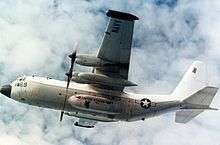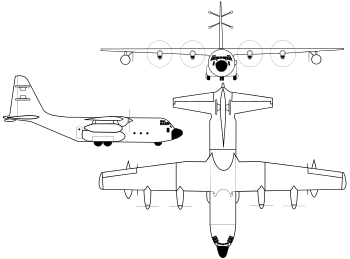Lockheed EC-130
| EC-130 | |
|---|---|
| | |
| The EC-130J Commando Solo with its distinctive tail antenna. | |
| Role | Airborne Communications Jamming (EC-130H) Psychological and Information Operations (EC-130J) |
| Manufacturer | Lockheed Aircraft Co. Lockheed Martin |
| Introduction | 1975 |
| Status | Active |
| Primary users | United States Air Force Air National Guard |
| Number built | 14 EC-130H 7 EC-130J |
| Unit cost | |
| Developed from | Lockheed C-130 Hercules Lockheed Martin C-130J Super Hercules |
The Lockheed Martin EC-130 series comprises several slightly different versions of the Lockheed C-130 Hercules that have been and continue to be operated by the U.S. Air Force and, until the 1990s, the U.S. Navy.
The EC-130E Airborne Battlefield Command and Control Center (ABCCC) was based on a basic C-130E platform and provided tactical airborne command post capabilities to air commanders and ground commanders in low air threat environments. The EC-130E ABCCC aircraft were retired in 2002 and the mission was 'migrated' to the E-8 JSTARS and E-3 AWACS fleets.
The EC-130E Commando Solo was an earlier version of a U.S. Air Force and Air National Guard psychological operations (PSYOPS) aircraft and this aircraft also employed a C-130E airframe, but was modified by using the mission electronic equipment from the retired EC-121S Coronet Solo aircraft. This airframe served during the first Gulf War (Operation Desert Storm), Operation Uphold Democracy, the second Gulf War (Operation Iraqi Freedom) and in Operation Enduring Freedom. The EC-130E was eventually replaced by the EC-130J Commando Solo and retired in 2006.
Based on a C-130H airframe, the EC-130H Compass Call is an airborne communications jamming platform operated by the Air Combat Command's (ACC) 55th Electronic Combat Group (55 ECG) at Davis-Monthan AFB, Arizona. The EC-130 Compass Call aircraft attempts to disrupt enemy command and control communications and limits adversary coordination essential for enemy force management. The Compass Call system employs offensive counterinformation and electronic attack capabilities in support of U.S. and Coalition tactical air, surface, and special operations forces. The EC-130H was used extensively in the Gulf War and Operation Iraqi Freedom, disrupting Iraqi communications at both the strategic and tactical levels. It has also been used in Operation Enduring Freedom in Afghanistan.
The EC-130J Commando Solo is a modified C-130J Hercules used to conduct psychological operations (PSYOP) and civil affairs broadcast missions in the standard AM, FM, HF, TV and military communications bands. Missions are flown at the maximum altitudes possible to ensure optimum propagation patterns. The EC-130J flies during either day or night scenarios with equal success, and is air-refuelable. A typical mission consists of a single-ship orbit which is offset from the desired target audience. The targets may be either military or civilian personnel. The Commando Solo is operated exclusively by the Air National Guard, specifically the 193d Special Operations Wing (193 SOW), a unit of the Pennsylvania Air National Guard operationally gained by the Air Force Special Operations Command (AFSOC). The 193 AOW is based at the Harrisburg Air National Guard Base (former Olmstead AFB) at Harrisburg International Airport in Middletown, Pennsylvania.
The U.S. Navy's EC-130Q Hercules TACAMO ("Take Charge and Move Out") aircraft was a land-based naval aviation platform that served as a SIOP strategic communications link aircraft for the U.S. Navy's Fleet Ballistic Missile (FBM) submarine force and as a backup communications link for the USAF manned strategic bomber and intercontinental ballistic missile forces. To ensure survivability, TACAMO operated as a solo platform, well away from and not interacting with other major naval forces such as sea-based aircraft carrier strike groups and their carrier air wings or land-based maritime patrol aircraft Operated by Fleet Air Reconnaissance Squadron THREE (VQ-3) and Fleet Air Reconnaissance Squadron FOUR (VQ-4), the EC-130Q was eventually replaced by the U.S. Navy's current TACAMO platform, the Boeing 707-based E-6 Mercury.
Design and development
The EC-130E Commando Solo entered service in 1978 as the EC-130E Coronet Solo with the Tactical Air Command (TAC). In 1983 the Coronet Solo's mission was transferred to the Military Airlift Command (MAC) and redesignated the EC-130E Volant Solo. With the formation of Air Force Special Operations Command, the mission was transferred to AFSOC and redesignated Commando Solo. Operations were consolidated under a single-AFSOC gained unit, the 193d Special Operations Wing (193 SOW) of the Pennsylvania Air National Guard. In the early 1990s the aircraft were upgraded and designated Commando Solo II. The EC-130E variants were replaced with new EC-130J Commando Solo III aircraft built by Lockheed Martin beginning in 2003.
Highly specialized modifications have been made to the latest version of the EC-130J (Commando Solo III). Included in these mods are enhanced navigation systems, self-protection equipment, and the capability of broadcasting color television on a multitude of worldwide standards throughout the TV VHF/UHF ranges.
Secondary missions include command and control communications countermeasures (C3CM) and limited intelligence gathering. The three variants are EC-130 ABCCC, EC-130E Commando Solo, and the EC-130J Commando Solo. The version currently in service is the EC-130J, as the last EC-130E was retired from service in 2006.
Operational history

The EC-130 was originally modified by using the mission electronic equipment from the EC-121S Coronet Solo. Soon after the 193rd SOG received its EC-130s, the unit participated in the rescue of US citizens in Operation Urgent Fury, acting as an airborne radio station informing those people on Grenada of the US military action. In 1989, Commando Solo was instrumental in the success of coordinated psychological operations in Operation Just Cause, again broadcasting continuously throughout the initial phases of the operation to help end the Manuel Noriega regime. In 1990 the EC-130 joined the newly formed Air Force Special Operations Command and has since been designated Commando Solo, with no change in mission.
More recently, in 1994, Commando Solo was utilized to broadcast radio and television messages to the citizens and leaders of Haiti during Operation Uphold Democracy. The EC-130s deployed early in the operation, highlighting the importance of PSYOP in avoiding military and civilian casualties. President Aristide was featured on the broadcasts which contributed significantly to the orderly transition from military rule to democracy.
The aircraft was also deployed during the 2010 Haiti earthquake, broadcasting a recording from Raymond Joseph (Haiti's ambassador to the United States) warning residents not to attempt to flee to the United States by sea. The aircraft also broadcast announcements of where earthquake victims can go for food and aid, news from Voice of America, and instructions on hygiene procedures to prevent disease.[2]
On the second day of Operation Odyssey Dawn, an EC-130J warned Libyan shipping "Libyan ships or vessels do not leave port, the Gaddafi regime forces are violating a United Nations resolution ordering the end to the hostilities in your country. If you attempt to leave port, you will be attacked and destroyed immediately. For your own safety do not leave port."[3] The unencrypted message in Arabic, French and English was recorded by a ham radio operator in the Netherlands.[4]
Variants

- EC-130E ABCCC
- EC-130E Commando Solo
- EC-130E Rivet Rider
- A version of the Commando Solo.[5]
- EC-130G
- four U.S. Navy C-130G (USAF C-130E) fitted with VLF transmitters to provide communications with ballistic missile submarines.
- EC-130H Compass Call
- EC-130J Commando Solo III
- EC-130Q
- U.S. Navy version of the C-130H, fitted with VLF transmitters to provide communications with ballistic missile submarines. 18 were built.
- EC-130V
- Airborne early warning and control variant used by USCG for counter-narcotics missions in 1991.[6] It was used by the U.S. Navy 1992-1994 and then by the USAF as NC-130H.
Aircraft on display
- EC-130Q USN BuNo 159348, c/n 4601
- TACAMO IV, ops with VQ-4, July 1975-July 1988; modified to TC-130Q, ops with VR-22, VXE-6; to Tinker AFB with VQ-3, VQ-4, "hack" aircraft as of December 1995. On static display by March 1997, same, July 2013.
- EC-130E USAF 62-1857
- Operation Eagle Claw Republic 5 aircraft. On static display at the Carolinas Aviation Museum October 2013.
- EC-130E USAF 63-7773 "Triple Cripple"
- On static display at Fort Indiantown Gap, Annville PA.
Specifications (EC-130J)

Data from US Air Force Factsheet[7]
General characteristics
- Crew: Pilot, CoPilot, combat systems officer, mission communications commander; loadmaster, five electronic communications systems operators (6+)
- Length: 97.75 ft (29.7 m)
- Wingspan: 132.6 ft (40.3 m)
- Height: 38.8 ft (11.8 m)
- Max. takeoff weight: 165,000 lb (74,840 kg)
- Powerplant: 4 × Rolls-Royce AE 2100D3 turboprop, 4,637 shp (3,458 kW)) each
- Propellers: Dowty R391 6-blade composite propeller, 1 per engine
Performance
- Cruise speed: 335 mph (540 km/h)
- Range: 2,300 nm (4,260 km)
- Service ceiling: 28,000 ft (8,500 m)
See also
- Related development
- Lockheed C-130 Hercules
- Lockheed Martin C-130J Super Hercules
- Lockheed AC-130
- Lockheed EC-130H Compass Call
- Lockheed HC-130
- Lockheed MC-130
- Lockheed WC-130
- Related lists
References
- ↑ "EC-130J Commando Solo". U.S. Air Force. United States Air Force. Retrieved 29 September 2015.
- ↑ "Radio station in the sky warns Haitians not to attempt boat voyage". CNN. 2010-01-19. Retrieved 2010-01-19.
- ↑ "Listen: Secret Libya Psyops, Caught by Online Sleuths". Wired. March 20, 2011.
- ↑ "Ham operator reveals US 'psyops' broadcast". AFP/News. March 21, 2011.
- ↑ EC-130E Commando Solo. military.com
- ↑ "Lockheed EC-130V Hercules." Military Analysis Network, Federation of American Scientists, 10 February 1998. Retrieved: 2 October 2010.
- ↑ "Factsheets: EC-130J Commando Solo". United States Air Force. Retrieved 2009-08-21.
External links
| Wikimedia Commons has media related to EC-130 Hercules. |
- EC-130E Commando Solo
- EC-130
- Factsheets: EC-130J Commando Solo
- Video of receiving Commando Solo transmission to Libya